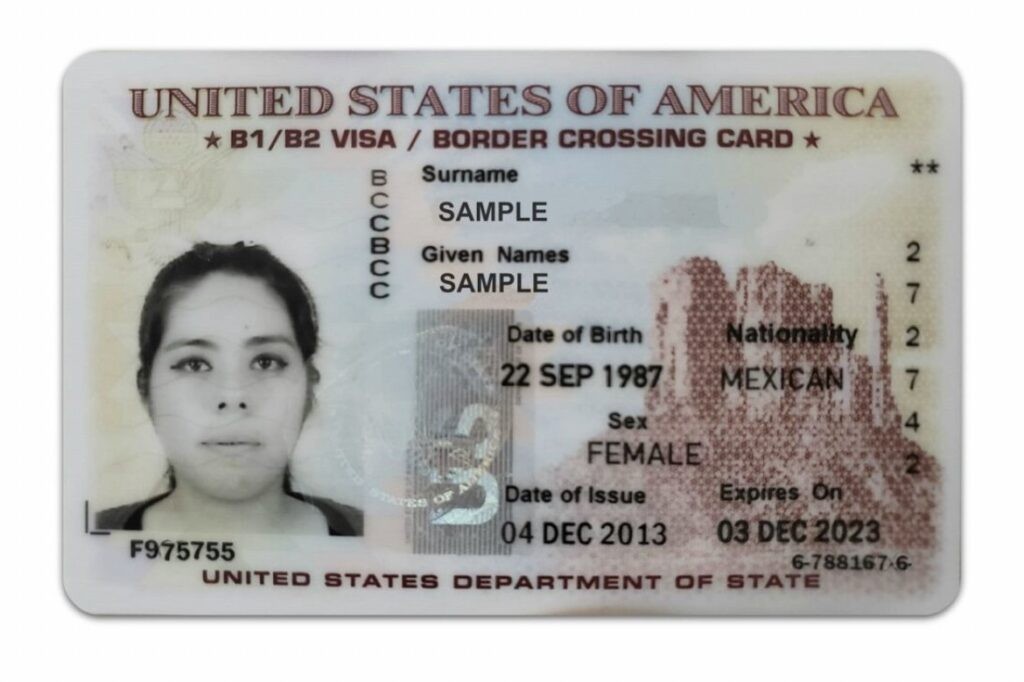A Border Crossing Card (BCC) offers Mexican citizens a convenient way to visit the United States. However, it’s essential to understand its limitations. This guide explains the travel restrictions associated with a BCC and what you need to know to plan your trip effectively.
Understanding the Border Crossing Card
 A close-up of a United States Border Crossing Card, highlighting its biometric features
A close-up of a United States Border Crossing Card, highlighting its biometric features
A Border Crossing Card functions as a B-1/B-2 visa for Mexican citizens, allowing entry into the U.S. for tourism, business, or a combination of both. It’s a laminated card, similar in size to a credit card, valid for multiple entries over a 10-year period. A key aspect to remember is that while the BCC allows frequent visits, it restricts the duration of each stay to a maximum of 30 days. Also, unlike a green card, it does not grant the right to work in the United States. To be eligible for a BCC, applicants must be Mexican citizens and residents, possess a valid Mexican passport, demonstrate sufficient financial resources for their trip, prove strong ties to Mexico (such as business ownership or property), and meet the standard requirements for a B-1 or B-2 visa.
Border Crossing Card vs. Visa: Key Differences
While a BCC serves as a B-1/B-2 visa, subtle yet important differences exist. The U.S. Department of State issues BCCs with machine-readable biometric data and a photo for easy scanning at ports of entry. These cards also contain an RFID chip, enabling immigration officials to quickly verify the holder’s identity. While both a BCC and a B-1/B-2 visa allow temporary visits for business or pleasure, the latter often requires a detailed itinerary, including specific travel and accommodation plans. The most significant distinction lies in the geographical limitations imposed on BCC holders, which we’ll explore in detail below. The Department of State may issue a combined B-1/B-2 visa in the form of a BCC or affix a foil on the individual’s Mexican passport.
Navigating Travel Restrictions: How Far Can You Go?
 A scenic view of the San Ysidro Land Port of Entry, the busiest border crossing in the Western Hemisphere, connecting San Diego and Tijuana.
A scenic view of the San Ysidro Land Port of Entry, the busiest border crossing in the Western Hemisphere, connecting San Diego and Tijuana.
The most crucial aspect to understand about a Border Crossing Card is the geographical limitations it imposes. The permitted travel distance varies depending on the state of entry:
- Texas and California: BCC holders can travel up to 25 miles from the border.
- New Mexico: The travel limit extends to 55 miles from the border.
- Arizona: The greatest distance is allowed here, with a limit of 75 miles from the border.
These restrictions can significantly impact your travel plans, so it’s vital to be aware of them.
Expanding Your Travel Radius: The I-94 Form
If you wish to travel beyond these designated zones, you’ll need to obtain an I-94 form. This form can be requested from a Customs and Border Protection (CBP) officer at the port of entry. A small fee is associated with obtaining the I-94. This form specifies the duration of your permitted stay in the United States. When using a BCC, the I-94 grants you B-1/B-2 status, allowing you to travel further into the country. While traditionally issued as a paper card (for land crossings), the I-94 is now primarily electronic at sea and air ports of entry. To complete the form, you’ll need your personal information (name, date of birth), date of entry, passport details, and visa status.
Understanding the Costs Involved
There is a fee associated with obtaining a Border Crossing Card, similar to the fees for most nonimmigrant visas. As of the latest update, the fees are as follows:
- Individuals aged 15 and over (valid for 10 years): $160.00
- Children under 15 (if a parent or guardian has or is applying for a BCC): $15.00
The reduced fee for children is contingent on at least one parent possessing a valid BCC. This reduced fee expires when the child turns 15. If the full fee is paid, the child’s BCC will be valid for the entire 10-year period.
Domestic Flights and the Border Crossing Card
The travel limitations associated with a BCC also affect domestic flights. While both citizens and non-citizens can generally fly domestically within the United States with a valid form of identification (such as a passport), the distance restrictions of the BCC may pose a challenge. For travel beyond the BCC’s geographical limits, obtaining the I-94 form at the port of entry is crucial. With the I-94, you can travel more freely within the U.S.
Conclusion: Navigating Your Travel Options
 A CBP officer inspecting documents, symbolizing the importance of understanding border crossing regulations.
A CBP officer inspecting documents, symbolizing the importance of understanding border crossing regulations.
While Border Crossing Cards offer a convenient way for Mexican citizens and residents to visit the United States for business or leisure, it’s critical to understand their limitations. The BCC allows stays of up to 30 days and restricts travel to a specific distance from the border, depending on the state of entry. Remember that a BCC does not authorize employment within the U.S. By understanding these regulations and utilizing the I-94 form when necessary, you can ensure a smooth and hassle-free experience when visiting the United States with your Border Crossing Card.